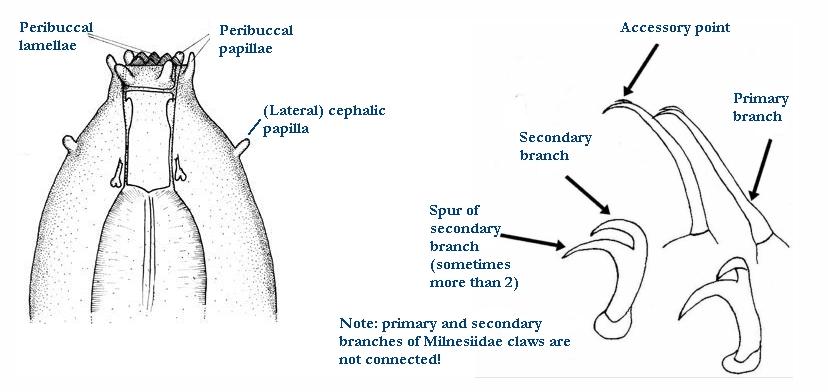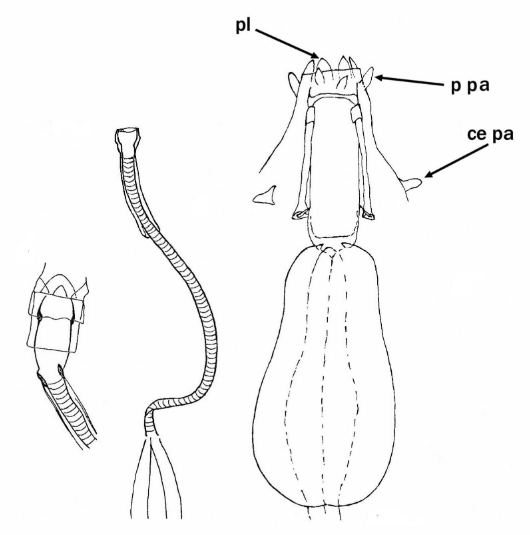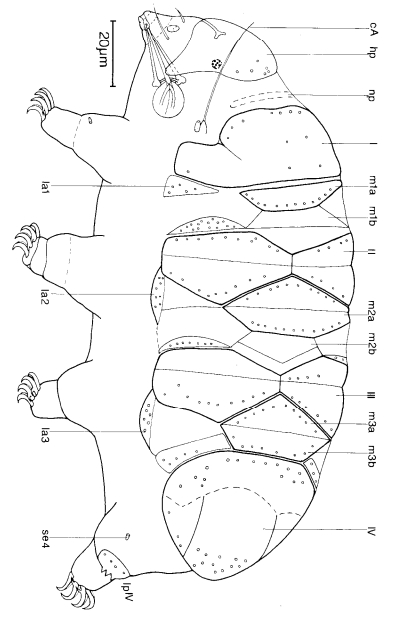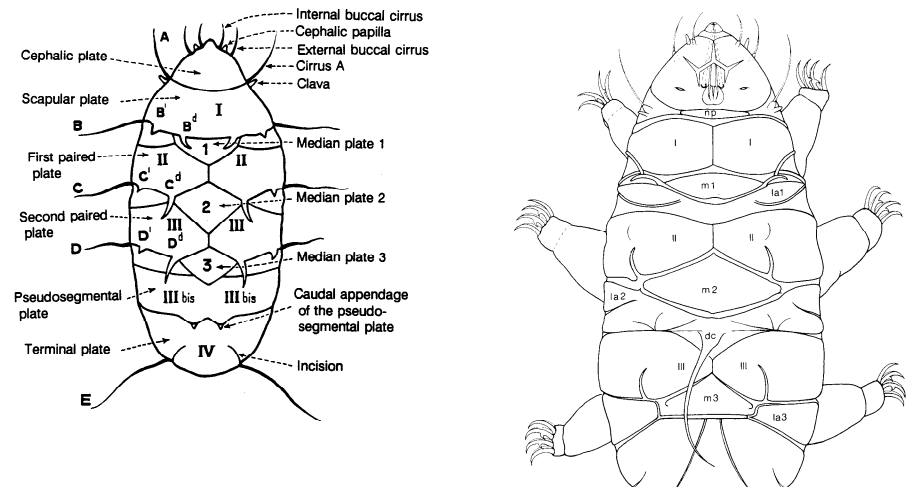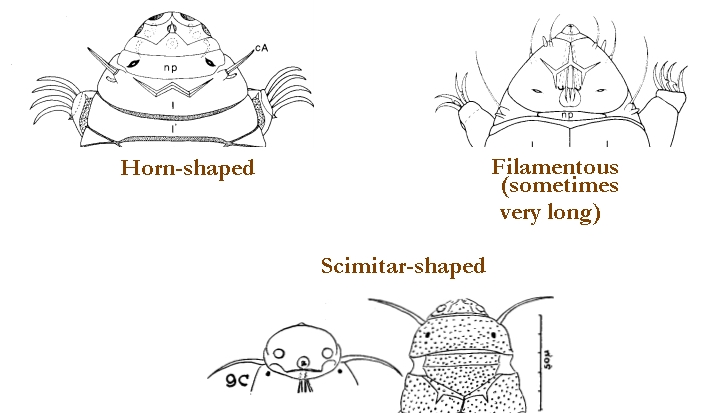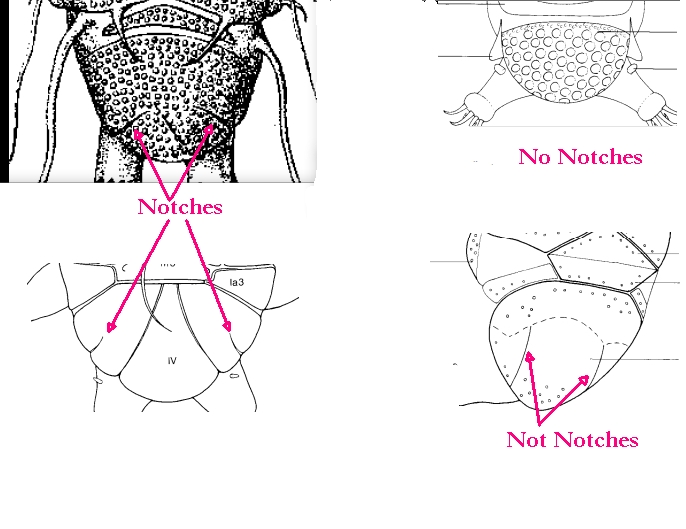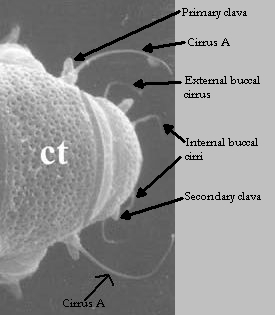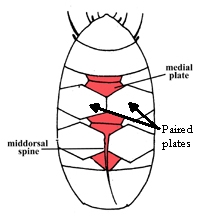Parachela

limno-terrestrial and marine species, one fossil species{Complete double claws on the legs with secondary claw branch joined to theprimary branch (secondary branch normally developed, reduced, or absent), ordouble claws completely lost. Buccal tube completely rigid, or subdivided intorigid and annulated flexible portions (pharyngeal tube); ventral lamina present orabsent; peribuccal and cephalic papillae absent; pharyngeal bulb […]
Eohypsibioidea

{Double claws similar in shape and arranged asymmetrically with respect to themedian plane of the leg (conventionally described as sequence 2121); claws may beof similar size; double claws of Eohypsibiidae type (¼Bertolanius type): subdividedinto three distinct sections, basal section, secondary branch and primary branch(rigidly joined to the secondary branch), one on top of the other […]
Eohypsibiidae

Eohypsibiidae from Marley et al. 2011: Eohypsibiidae-type claws, which are clearly delineated by septa, in linear order, from basal section, secondary branch and primary branch. The angle between basal section, secondary branch and primary branches are different between claws on the same leg and the internal claw can rotate on its base by 180°. Need description here […]
Milnesiidae

Milnesiidae, from Schuster et al. 1980: “…which has cephalic papillae and has claws with well-separated primary and secondary branches…” {as the order} (Bertolani et al. 2014) (Degma P, Guidetti R. 2018. Tardigrade Taxa. In: Water Bears: The biology of tardigrades. Schill RO, Editor. Switzerland: Springer Nature. p. 371-409. DOI: 10.1007/978-3-319-95702-9_15.) Citations: Schuster RO, Nelson DR, […]
Apochela

limno-terrestrial species, one fossil species{Double claws of Milnesiidae type (primary and secondary branches are completelyseparated). Buccal tube completely rigid, or subdivided into rigid and flexibleportions, or completely flexible; ventral lamina absent; six peribuccal papilae andsix or only four peribuccal lamellae present; two lateral papillae on the head(cephalic papillae) present; apophyses for the insertion of the […]
Eutardigrada

limno-terrestrial, and marine species; two fossil species{Without cephalic appendages such as cephalic cirri, lateral cirri A or clavae, onlyperibuccal and lateral papillae can be present; gonopore not separated from anus; twodouble claws composed of a primary and a secondary branch fused or positioned onebehind the other (secondary branch can be reduced or absent, or claws […]
Heterotardigrada

marine, limnic and terrestrial species{Cephalic appendages, lateral cirri A included, present. Gonopore separated fromanus. Malpighian tubules lacking. Placoids in the pharynx consisting of three CaCO3elements or three delicate, bar-shaped cuticular structures.} (Kristensen 1987) (Degma P, Guidetti R. 2018. Tardigrade Taxa. In: Water Bears: The biology of tardigrades. Schill RO, Editor. Switzerland: Springer Nature. p. 371-409. […]
Echiniscoidea

marine, limnic and terrestrial species{Claws inserted on minuscule papillae positioned at the end of the legs, which arenot digitate. Median cirrus generally absent.} (Richters 1926) (Degma P, Guidetti R. 2018. Tardigrade Taxa. In: Water Bears: The biology of tardigrades. Schill RO, Editor. Switzerland: Springer Nature. p. 371-409. DOI: 10.1007/978-3-319-95702-9_15.)
Echiniscidae

terrestrial species (found also in freshwater){Seminal receptacles absent. Dorsal plates present. Adult with 4 claws on each leg.}(Kristensen 1987) (Degma P, Guidetti R. 2018. Tardigrade Taxa. In: Water Bears: The biology of tardigrades. Schill RO, Editor. Switzerland: Springer Nature. p. 371-409. DOI: 10.1007/978-3-319-95702-9_15.)




